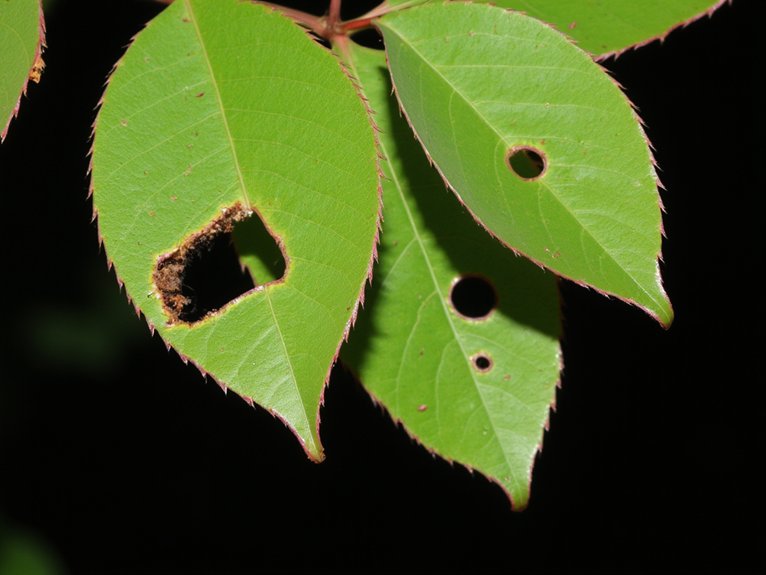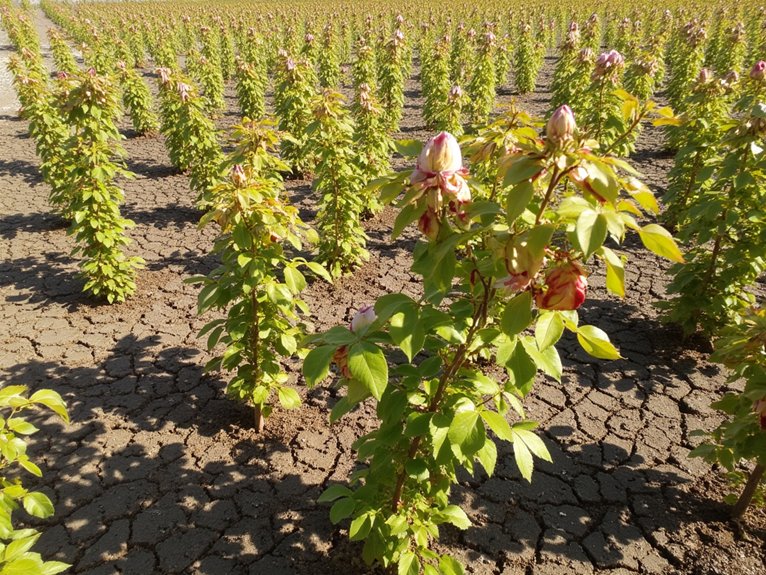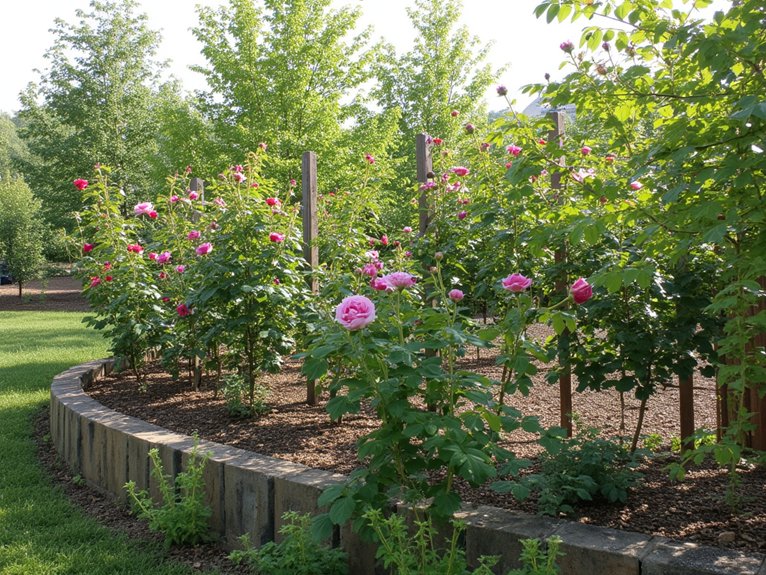Like a detective investigating tiny crime scenes, discovering holes in rose leaves sends gardeners on a mission to identify the culprits. Plant pathologist Dr. Sarah Chen notes that “the pattern and timing of damage often tells us exactly who’s responsible.” While Japanese beetles create distinctive lace-like patterns during daylight hours, nighttime raiders like slugs leave ragged evidence of their feasts. Understanding these telltale signs marks the first step toward reclaiming a garden’s beauty.
Contents
Common Culprits Behind Rose Leaf Damage

Gardeners often discover mysterious holes in their prized roses, leaving them wondering what’s causing the damage. Several common pests target roses, each leaving distinctive signs that aid in pest identification. Rose chafer beetles, measuring ½ inch long, create large holes in spring, while sawfly larvae leave tan “windowpane” splotches. Japanese beetles, with metallic green bodies, skeletonize leaves during daylight hours. Beneficial leafcutter bees make clean, round cuts along leaf edges for nesting material. Storm damage, particularly from hail, can also create holes that mimic pest activity. Understanding leaf damage patterns helps determine the appropriate response.
How to Identify Different Types of Holes
When examining holes in rose leaves, distinct patterns reveal the likely culprits behind the damage. Ragged, irregular holes often indicate slug activity, while clean, circular cuts point to leafcutter bees. Japanese beetles create skeletal leaves by eating between the veins, leaving a lace-like appearance.
For accurate pest identification, observe these hole patterns:
– Perfect circles along leaf edges: Leafcutter bees
- Large, irregular holes with smooth edges: Rose chafer beetles
- “Windowpane” transparent patches: Sawfly larvae
- Nighttime feeding damage with slime trails: Slugs and snails
- Morning inspections when pests are most visible
- Weekly documentation of any holes or damage patterns
- Monthly assessment of overall plant health
- Seasonal pruning of affected areas
Weather’s Impact on Your Rose Garden

While insect damage creates distinct patterns in rose leaves, Mother Nature can inflict equally devastating effects on your garden. Understanding weather patterns helps gardeners protect their roses from unexpected storms, particularly hail damage.
When forecasts predict severe weather, storm preparation becomes critical. A sturdy tarp supported by stakes can shield roses from hailstones, while overturned buckets protect smaller plants. “Hail as small as pea-size can shred tender leaves and break delicate stems,” notes rosarian Emily Chen.
Mounding soil around the base of roses provides extra stability during high winds, helping prevent permanent damage to established plants.
Natural Solutions for Protecting Your Roses
Natural methods offer the most sustainable and environmentally friendly approach to protecting roses from common garden pests. Companion planting with marigolds and garlic acts as natural deterrents, while introducing beneficial insects like ladybugs helps control harmful pests naturally.
“A diverse garden ecosystem is your best defense,” says botanist Dr. Sarah Chen. Organic treatments like neem oil can deter Japanese beetles, while copper strips around garden beds keep slugs at bay. For leaf-eating insects, a mixture of water and mild soap provides an effective deterrent when sprayed weekly during peak pest seasons.
Creating a Pest-Resistant Rose Garden

Building a pest-resistant rose garden starts with selecting naturally hardy varieties that can withstand common garden threats. “Disease-resistant cultivars like ‘Knockout’ roses provide built-in protection against many pests and require less intervention,” explains rosarian James Martin of the American Rose Society.
Companion planting plays a crucial role in natural pest management. Planting lavender, garlic, and marigolds near roses helps deter harmful insects while attracting beneficial ones. These helpful garden allies include ladybugs and parasitic wasps that feed on common rose pests.
Creating diverse plantings also strengthens the garden’s natural defense systems, reducing the need for chemical controls.
Essential Monitoring and Maintenance Tips
Regular monitoring forms the backbone of effective rose care, building upon the protective foundation of companion planting. Experts recommend checking roses three times weekly during growing season, focusing on leaf undersides and new growth.
A consistent maintenance schedule includes:
“Early detection means faster intervention,” notes rosarian Dr. Sarah Chen. “Look for signs during routine watering – it’s the perfect time to spot potential issues before they become serious problems.”
